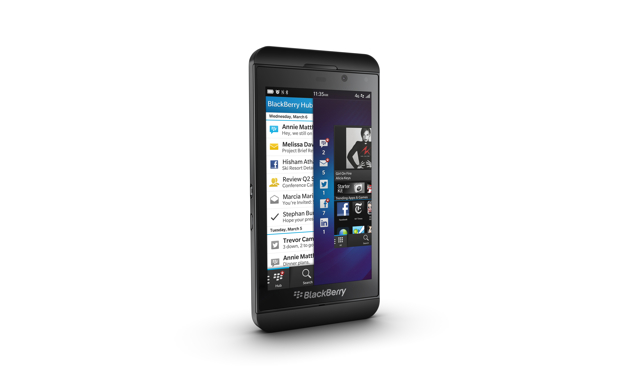Over the past 16 years, Macadamian has applied its software development and user experience expertise to hundreds of projects for desktop, Web, and mobile platforms. We have worked with more than 500 companies on four continents. Working across multiple industry verticals and with a diverse client base has been a key factor in our continued growth.
But when the opportunity came to work on BlackBerry 10, we took a risk—a big risk, some might say—by dedicating one-quarter of our workforce to this new OS platform. This included interaction designers, researchers, visual designers, prototypers, software developers, technical architects, and project managers, along with a substantial amount of our executive team’s time.
This was no small gamble. Macadamian is a mid-sized company with a workforce of just over 200. The decision was not made lightly, especially because the platform is one that some industry watchers believe has come too late to the smartphone party.
As the work commenced behind the scenes on BlackBerry 10 and the buzz grew in the development community, we realized something truly distinct and innovative was on its way and we wanted to be a part of it. BlackBerry 10 represents a fundamental philosophical change in how the company once known as Research in Motion is engaging with the development community and responding to the needs of the consumer.
We are also bullish on the business potential of BlackBerry 10, and excited about a rich UI that allows the device to easily serve as a communications device and an application device at the same time.
Let’s start with our experience working with BlackBerry and as part of its developer ecosystem.
A Dynamic Community
We’ve been working closely with BlackBerry on BlackBerry 10 for more than a year. While BlackBerry has driven the overall user experience, we’ve been engaged in many aspects of UX design and product creation for more than a dozen BlackBerry 10 applications to date. These include #Taxi from Cellwand Communications and the conference app for the 2013 BlackBerry Jam Europe conference.
We dipped our collective toes in the water by participating early on in BlackBerry’s developer forums. Drawing on our own expertise, we helped other developers resolve their design and UX challenges. It soon became clear to us that BlackBerry was making a great effort to create a healthy and dynamic ecosystem, valuing the contributions of individual developers with the same passion it did the end users of its devices. Indeed, the company had come to realize that it had two target markets that were equally important.
Our efforts soon captured BlackBerry’s attention and we became part of the BlackBerry Alliance Partner program. BlackBerry 10’s operating system user experience, with its Flow and Peek functions, provided us with a great opportunity to innovate and elevate the user experience at the application level. BlackBerry supported our efforts by vetting our designs with end users and collecting their feedback.
Since BlackBerry 10 was still a platform in development, the onus was on us to keep up with changing development and design guidelines. This was both exciting and challenging as BlackBerry iterated and evolved the guidelines on an ongoing basis as they took advantage of insights from their users and their own internal teams. Because the platform’s UI relies on hand gestures that have never been used before with a touch screen (for instance, some of them start off-screen versus those that start on-screen) we had to come up with easy and intuitive demo hints and tutorials that would allow an end user to quickly climb that learning curve.
Our biggest challenge was not the guidelines themselves, but how to react and maintain momentum in application design and development when something as fundamental as the operating system’s user experience was evolving right before our eyes. Each app that we developed or ported also had to accord with the client’s vision, standards, and brand image, which often hinged on the smallest of details.
For example, when a list item is displayed on a BlackBerry 10 device, there is no border around the list. But one client insisted that its lists have a border and that the border at the top have rounded edges. We had to develop code to adapt the standard platform to meet that client’s requirements.
BlackBerry 10 has Big Business Potential
BlackBerry has a worldwide ecosystem that is particularly strong for the enterprise market. It is well known for the security of its platforms. However, its efforts to ensure a reliable and secure “company experience” has often come at the expense of the individual’s personal experience outside of work. It’s become common for people to carry a BlackBerry device for work and an iPhone for leisure.
BlackBerry has bridged this divide in the BlackBerry 10 platform with Balance, a simple and secure way for users to manage, and separate, their work and personal data. Users’ personal apps can’t access work information, and work information can’t be copied and pasted into personal apps or email messages. An employer or administrator can easily wipe sensitive information from the device remotely if it is lost or stolen, or when employees leave an organization. We believe that Balance will provide BlackBerry with a competitive edge against iOS and Android devices and allow it to expand its share of the broader consumer market.
But let’s not forget that BlackBerry already enjoys a vast and loyal global user base willing to pay more for apps and services delivered on such a secure and stable platform. According to a Vision Mobile 2012 study, BlackBerry apps make more money—38% more than Android and 4% more than iOS. This will continue to be a huge incentive for companies to develop apps for BlackBerry 10. The larger the application ecosystem becomes, the greater the market traction BlackBerry 10 will have.
We were provided with early access to the BlackBerry 10 platform and this allowed us to contribute to their development process even as we honed our own expertise. We strive to become experts in design and user experience on all of the latest platforms, and BlackBerry was there at every step to help us along.
A User Experience like None Other
We feel confident vouching for BlackBerry 10’s rich user experience, the ease in which it can be used with natural gestures, and its utility as both a communications and applications device that provides users with one continuous experience.
BlackBerry 10 had already attracted an enthusiastic user base before it even hit the market. It was common for developers and designers working on the platform to give up their current device because they loved the BlackBerry 10 user experience. This largely stems from the fact that the workspace and flow is more similar to the flow achieved on a desktop than on a traditional smartphone.
What BlackBerry has been able to do is distill the ubiquitous availability of menus and tools typical of a desktop’s large screen into the much smaller form factor of a phone. It’s easy to “flip” back and forth between applications and manage communications with the Peek function. Peek allows users to take a discreet look at an incoming communication to determine if it warrants an immediate response without breaking the task flow of their current application.

BlackBerry 10’s approach to task switching, to hub integration, and to keeping communication at its core, while at the same time allowing users to return to tasks in mid-stream, allows them to maintain a workflow that is as complex as it might be on a desktop. The user begins to feel like the workspace extends beyond the handset, which is a far different experience than the traditional approach of mobile platforms, which limits the user to single-app, single-window tasks.
This, of course, means that it is also a whole new world for developers. But BlackBerry has a well-defined library of design patterns that are easily accessible and easy to use, which give trained designers clear guidelines to deliver an authentic BlackBerry 10 experience.
We’re obviously big fans of the BlackBerry user experience—not just because we worked on it, but also because we’ve seen it working first hand. Like any other device or software program, it’s not all things to all users. But for the user base that BlackBerry is targeting, we believe it’s done something exceptional and it’s been fun to be a part of it.








